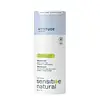What's inside
What's inside
 Key Ingredients
Key Ingredients

 Benefits
Benefits

 Concerns
Concerns

 Ingredients Side-by-side
Ingredients Side-by-side

Magnesium Hydroxide
AbsorbentCocos Nucifera Oil
MaskingVitis Vinifera Seed Oil
EmollientUndecane
EmollientHelianthus Annuus Seed Wax
Skin ConditioningCoco-Caprylate/Caprate
EmollientTridecane
PerfumingC10-18 Triglycerides
EmollientWater
Skin ConditioningBehenyl Behenate
EmollientRicinus Communis Seed Oil
MaskingKaolin
AbrasivePolyhydroxystearic Acid
EmulsifyingEuphorbia Cerifera Wax
Glyceryl Behenate
EmollientGlycerin
HumectantTocopherol
AntioxidantAvena Sativa Kernel Extract
AbrasiveMagnesium Hydroxide, Cocos Nucifera Oil, Vitis Vinifera Seed Oil, Undecane, Helianthus Annuus Seed Wax, Coco-Caprylate/Caprate, Tridecane, C10-18 Triglycerides, Water, Behenyl Behenate, Ricinus Communis Seed Oil, Kaolin, Polyhydroxystearic Acid, Euphorbia Cerifera Wax, Glyceryl Behenate, Glycerin, Tocopherol, Avena Sativa Kernel Extract
Cocos Nucifera Oil
MaskingSolanum Tuberosum Starch
AbsorbentCoco-Caprylate/Caprate
EmollientHelianthus Annuus Seed Wax
Skin ConditioningCarthamus Tinctorius Seed Oil
MaskingPolyhydroxystearic Acid
EmulsifyingTriethyl Citrate
MaskingZinc Ricinoleate
Magnesium Hydroxide
AbsorbentLauryl Laurate
Skin ConditioningSambucus Nigra Fruit Extract
AstringentGlyceryl Laurate
EmollientSalvia Officinalis Oil
MaskingHelianthus Annuus Seed Oil
EmollientTocopherol
AntioxidantGlyceryl Caprylate
EmollientGlyceryl Undecylenate
EmollientEthylhexylglycerin
Skin ConditioningSodium Caproyl/Lauroyl Lactylate
AntimicrobialCocos Nucifera Oil, Solanum Tuberosum Starch, Coco-Caprylate/Caprate, Helianthus Annuus Seed Wax, Carthamus Tinctorius Seed Oil, Polyhydroxystearic Acid, Triethyl Citrate, Zinc Ricinoleate, Magnesium Hydroxide, Lauryl Laurate, Sambucus Nigra Fruit Extract, Glyceryl Laurate, Salvia Officinalis Oil, Helianthus Annuus Seed Oil, Tocopherol, Glyceryl Caprylate, Glyceryl Undecylenate, Ethylhexylglycerin, Sodium Caproyl/Lauroyl Lactylate
Ingredients Explained
These ingredients are found in both products.
Ingredients higher up in an ingredient list are typically present in a larger amount.
Coco-Caprylate/Caprate is created from fatty coconut alcohol, caprylic acid, and capric acid.
It is a lightweight emollient. Emollients create a thin barrier on the skin to trap moisture in. This helps keep your skin hydrated and soft.
Once applied, Coco-Caprylate/Caprate is absorbed quickly and leaves a silky feel.
Coco-Caprylate/Caprate may not be fungal acne safe.
Learn more about Coco-Caprylate/CaprateCocos Nucifera Oil is obtained from the kernels of the coconut fruit. In other words, this is coconut oil.
Coconut Oil is rich in fatty acids with lauric acid making up the majority of these. It also contains linoleic acid. Due to this high fatty acid content, coconut oil helps trap moisture and soften skin.
Despite being antibacterial, coconut oil may not be great for acne-prone skin. It is comedogenic and may clog pores. This ingredient may not be safe for malassezia or fungal acne.
Note: Coconut Oil should not replace your sunscreen for UV protection. Studies show it only blocks about 20% of UV.
This oil is non-volatile and has a light scent.
The term 'fragrance' is not regulated in many countries. In many cases, it is up to the brand to define this term. For instance, many brands choose to label themselves as "fragrance-free" because they are not using synthetic fragrances. However, their products may still contain ingredients such as essential oils that are considered a fragrance.
Learn more about Cocos Nucifera OilHelianthus Annuus Seed Wax is created from the common sunflower.
Sunflower seed wax is made up of long chain non-glyceride esters, a small amount of fatty alcohols, and fatty acids.
This ingredient is often used to enhance the texture of products. The fatty acid properties also help hydrate the skin.
Learn more about Helianthus Annuus Seed WaxWe don't have a description for Magnesium Hydroxide yet.
Polyhydroxystearic Acid is a soft wax made from castor oil.
It is is a texture thickener, emulsifier, and film-former. Emulsifiers prevent ingredients from separating, such as oils and waters.
Polyhydroxystearic Acid may not be fungal acne safe.
Learn more about Polyhydroxystearic AcidTocopherol (also known as Vitamin E) is a common antioxidant used to help protect the skin from free-radicals and strengthen the skin barrier. It's also fat soluble - this means our skin is great at absorbing it.
Vitamin E also helps keep your natural skin lipids healthy. Your lipid skin barrier naturally consists of lipids, ceramides, and fatty acids. Vitamin E offers extra protection for your skin’s lipid barrier, keeping your skin healthy and nourished.
Another benefit is a bit of UV protection. Vitamin E helps reduce the damage caused by UVB rays. (It should not replace your sunscreen). Combining it with Vitamin C can decrease sunburned cells and hyperpigmentation after UV exposure.
You might have noticed Vitamin E + C often paired together. This is because it is great at stabilizing Vitamin C. Using the two together helps increase the effectiveness of both ingredients.
There are often claims that Vitamin E can reduce/prevent scarring, but these claims haven't been confirmed by scientific research.
Learn more about Tocopherol